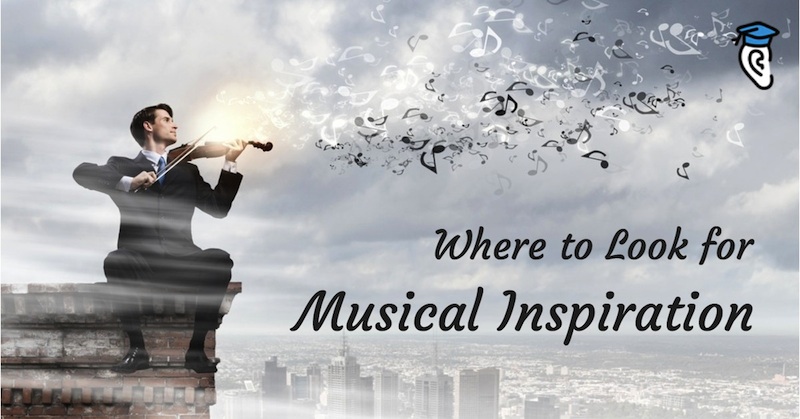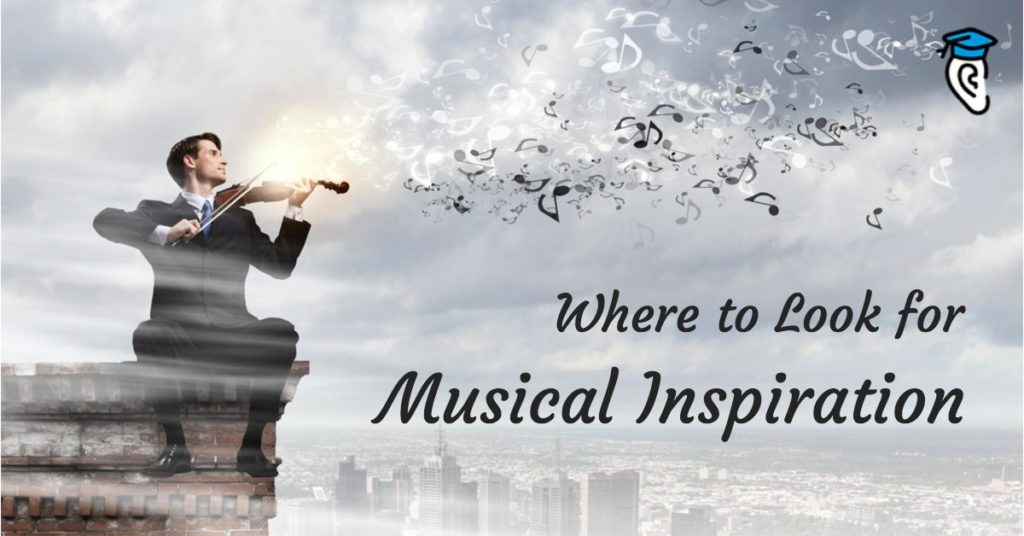How many times when making music did you feel like you lacked that sparkle to either start or finish a song? The good news is that you aren’t the only one! All artists experience creative blocks from time to time and each have different means of tackling it. Let’s talk all about inspiration and how to help develop a better flow of ideas.

Probably the most important thing to understand is that you have to keep cool and don’t ever get discouraged. You’re a star and you’re here to make music that’s the bomb.
There’s one asset you can develop as a composer or songwriter which can help you whenever you lack inspiration. We’re going to introduce this idea and then go through several examples; covering composition inspiration topics such as song structure, instrumentation, and “call and response”.
Reference Tracks
Let’s assume you want to make a record. In this case a lot of things have to be taken into consideration and there are a few tricks to help you. The first thing that comes to mind is you have to set your own goals straight in front of you, both the technical and emotional aspects.
By technical we mean you have to have a clear vision of the genre, tempo, key, and any other songwriting or production techniques that you are about to use. The emotional side is where you can conceptualize about the purpose of your record: what kind of emotions you want to express, why is this record being made and so on.
This is where reference tracks come into play. Nailing down the emotional side is completely up to you, because you’re speaking for yourself. The inspiration for the technical element can come from other artists’ recordings.
A reference track provides an immediate and coherent structure of what you’re about to compose. You would be surprised how artists and producers surgically dissect pre-existing songs; and even use several reference tracks for different sections of their new song. This can really take the pressure off when your studio time is limited.
To find suitable reference tracks you will need to employ active listening – meaning you truly listen to the music around you each day, not just hear it.
“To listen is an effort, and just to hear is no merit. A duck hears also.”
– Igor Stravinsky
Song Structure
Check out this record by Hayden James called “Something About You”:
Let’s imagine you want to compose a similar tropical house piece and this is your reference track. Listen to a full reference track and lay out the ideas for your song. Label each section, and the number of bars, like this:
- Intro – 8 bars
- Intro Embellished – 8 bars
- Breakdown – 8 bars
- Breakdown Embellished – 8 bars
- Chorus – 8 bars etc.
Everyone has different ways of doing this: some may draw little graphs, others write it out in words. The result is an immediate picture of your future song which you can extend or contract.
Try applying the same approach to “Love Has Gone” by Netsky:
This track is total bliss and also a perfect example to hone your song structure skills. Notice how each section is renewed every 8 bars, either by adding or subtracting musical elements.You can clearly hear how elements come into play and the impact they have on overall progress of a tune.
Instrumentation
So now that you have a solid vision of the song structure let’s move on to instrumentation. Depending on the genre, you would typically have a certain group of instruments representing that style. If it’s rock you have drums, guitars, vocals, bass, keys; if it’s a string quartet you would have two violins, a viola and a cello; if you’re into bass house you would have drums, FX, wobble and growl basses, vocals and so on.
So how would you analyze the instrumentation? What can ignite your inspiration and propel your track to the next level?
Our next example is “Make Me Feel” by Gold Fields, featuring KLP on the vocals:
Listen to the first 8 bars: what do you hear? You have a kick drum, a pad, vocal chops, some light percussion, cymbals, FX, and static noise. This is already a lot to work with!
Let’s move on to the next 8 bars. Kick drum left out, the chords stay, some light percussion as well, and the vocals come in.
By proceeding in similar fashion and writing down everything you hear, you can really get lots of ideas to work with.
Try the same approach on this newest recording by DJ Snake called “Middle” featuring Bipolar Sunshine:
By applying active listening and really focusing on the sounds you hear, you will also internalize how certain elements interact. There are multiple little intricacies that pop up, like a cymbal that is played in response to vocals, or a little drum break to anticipate the next section.
Call and Response
Now that you have a clear picture of your structure and instrumentation, it is time to start on the music. One great technique that has worked since the inception of music is call and response.
In music, the call and response approach allows us to create coherent ideas that interact with each other and contribute to the overall integrity of a record. This technique was perfected by blues and rock musicians but pops up on just about every record on earth.
Here’s a very prominent example of call and response in Led Zeppelin’s song “Black Dog”. This track makes this technique so obvious: a standalone vocal hook followed by nothing but instruments. Simple and effective.
Call and response takes on many forms and degrees. You will find a more subtle example in Skrillex’ remix of Benny Benassi’s “Cinema”. Jump to [0:37] to hear a breakdown part. Notice how vocals are answered with a little bell melody every 4 bars:
You don’t need two or more instruments to create call and response. It is the key to constructing coherent melodic phrases. Let’s have another look at the vocals in “Cinema”, in that same breakdown:
You are a cinema
I could watch you forever
Action, thriller
I could watch you forever
Here “You are a cinema” represents a melodic question and “I could watch you forever” is an answer that resolves the tension created in the first phrase. The same is true for the entire vocal section.
In conclusion, listening to as much music as possible with an analytical approach is the key to inspiration. Do everything for a reason, so after every activity you can confidently say that you made progress, accomplished and learned something. Using reference tracks will give you great ideas! Don’t ignore what other fantastic musicians have accomplished: it’s all part of universal knowledge for us to grow on!







